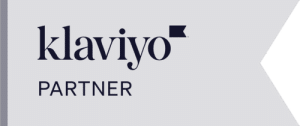Many marketers right now (us included) are pulling their hair out over ‘the absolute end of the world as we know it’, otherwise known as Apple’s latest impending update; iOS14.5. With warning messages plastered all over our Facebook ad accounts, we have to ask – what is it, does it affect me and, of course, why the &%&$ are Apple doing this to small businesses during a pandemic?
UPDATE: We are continually updating this blog with post-iOS14.5 known issues and fixes for Facebook ads manager. Scroll to the bottom of the blog to find updates.
What is the iOS 14.5 update ‘App Tracking Transparency’ (ATT)?
It seems Apple is the latest to jump on the “I hate Facebook” bandwagon with their latest iOS 14.5 update. Within this update currently on it’s way to you and your consumers, Apple will be releasing a privacy feature called App Tracking Transparency (ATT). This feature will generate a pop up asking users to actively opt in to tracking from apps including the Facebook app. Despite Mark Zuckerberg’s very personable and data-responsible reputation, especially after the latest WhatsApp tracking faux-pas (if you can call it that), we reckon the vast majority of users might not be eager to opt in to tracking from Facebook.
Below, you can see a preview of what this pop up will look like as provided by Apple Insider from the beta version of iOS14.5 currently in rotation, having been released in late December:
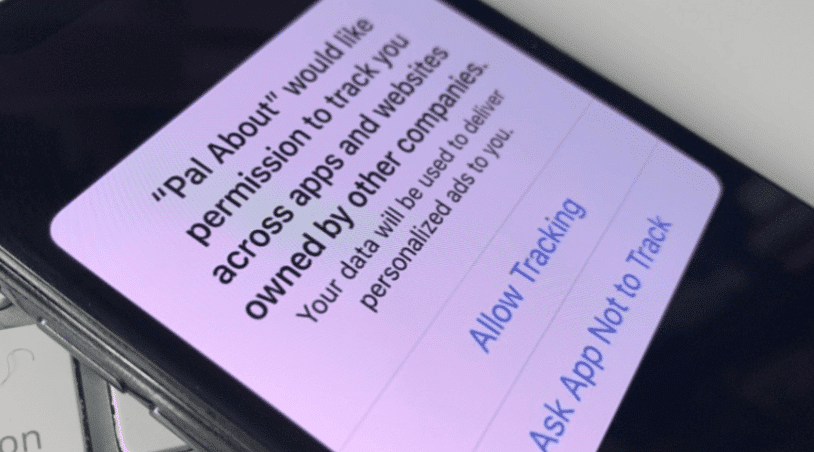
Facebook themselves have objected to Apple’s privacy update, stating that this new feature hurts businesses. This is especially true during a pandemic where so many small businesses have turned to ecommerce and online advertising to keep their doors open (figuratively speaking) and food on the table. Facebook themselves stated:
“We disagree with Apple’s approach and solution. We understand how disruptive Apple’s changes may be to your business, and are committed to helping you manage through them”.
In fact, Facebook is so very against the update that they paid for full-page newspaper print ads in The Wall Street Journal, New York Times and The Washington Post to hit back at Apple (clearly they’re not pulling their punches).
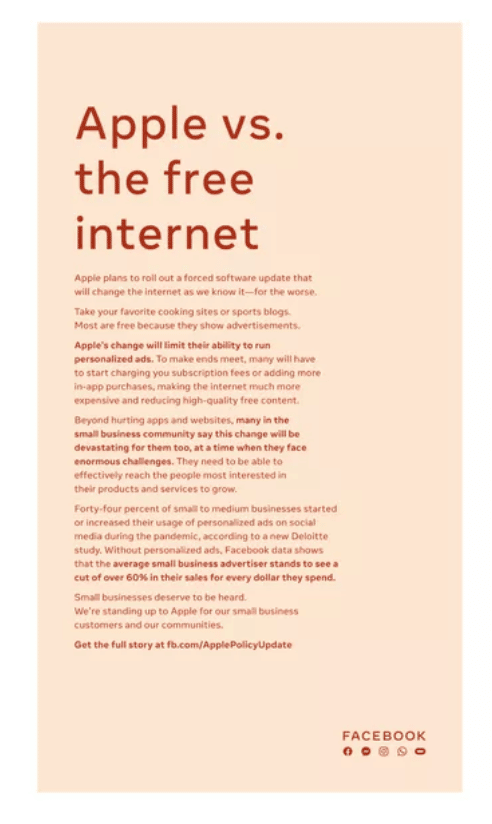
Apple CEO, Tim Cook, responded on Twitter:
We believe users should have the choice over the data that is being collected about them and how it’s used. Facebook can continue to track users across apps and websites as before, App Tracking Transparency in iOS 14 will just require that they ask for your permission first. pic.twitter.com/UnnAONZ61I
— Tim Cook (@tim_cook) December 17, 2020
All public spats aside, what does all of this mean for the Facebook app and Facebook advertisers if iOS users are truly in control of their data sharing?
The effects of iOS 14.5 on Facebook ads
The iOS 14.5 update from Apple, as previously stated, will heavily impede Facebook’s ability to track users using their Facebook app. This update will be significant for advertisers as, within the UK, iPhones have a 46.65% market share of the mobile market (as of September 2020). This market share becomes even more impactful when we consider the weight of the market within the larger e-commerce purchasing pool of 24-34 year olds.
These changes will affect all advertising using Pixel Events (Landing Page Views, Purchases, Leads etc.) and iOS App Installs targeting. Currently, these are some of the areas known to be affected by the update for Facebook ads accounts:
- Event Management and Targeting
- Delivery
- Measurement/Reporting
Event Management and Targeting
Facebook Events are a fancy way to describe what is essentially conversion tracking. These can be Standard Events with set codes that developers and marketers can add to their websites to track events (like Purchase, Add to Cart, Lead etc.) or Custom Events/Conversions (Tracking a conversion event that is customised to your site and doesn’t fit the parameters of any Standard Event e.g. Facebook’s example is to trigger events for purchases of women’s shoes over USD 40 only. This can be useful segmentation for upselling purposes).
Previously in Events Manager users have had the freedom to create as many Standard Events and Custom Events as their hearts desire. This can be especially useful for larger websites with stock segmentation or separates sides to a website e.g. b2c/b2b. Data bliss.
With the latest iOS 14.5 update, not only will Facebook ads be under-reporting due to a mass amount of users opting out but advertisers will also be limited to tracking a maximum of 8 conversion events including Custom and Standard events. Facebook have stated that “the 8 conversion events per domain will be ranked based on priority. If multiple events are completed by a user (i.e. “add to cart” and “purchase”) only the higher prioritized event will be reported.” This means that, as we understand it, not only will all websites be capped in their tracking capabilities by Facebook but also that you will not gain a full picture of your customer journey. What we believe “only the higher prioritized event will be reported” to mean is that you may end up with more Purchases than Add to Cart in some cases which is quite confusing at best.
Update (9th February 2021):
We can now see a live solution in our Events Manager dashboard for prioritising and culling the number of events we track within our Facebook ads platform. This is called “Aggregated Event Measurement”. AEM, and the 8-max rule as well as single-tracking priority of events will allow us to continue to gather “aggregated” and “anonymised” data from iOS users who have opted you (you will find this “learn more” information shown below in your Events Manager).
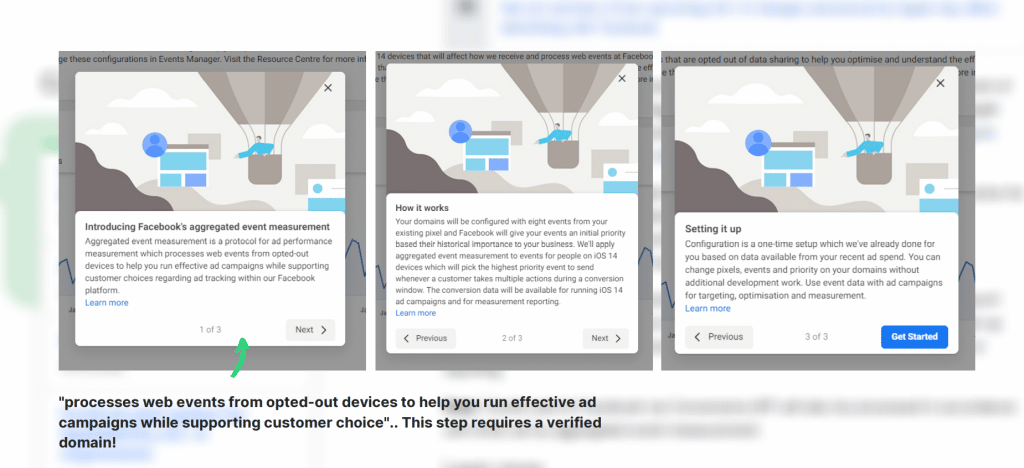
Ultimately, the reason we can still see conversion data from these users is that the data itself passes through Apple before being sent to Facebook through their “Private Click Management”. Apple essentially anonymises and controls the data that gets sent to Facebook. This is ultimately why we have these new events rules in place, to appease Apple.
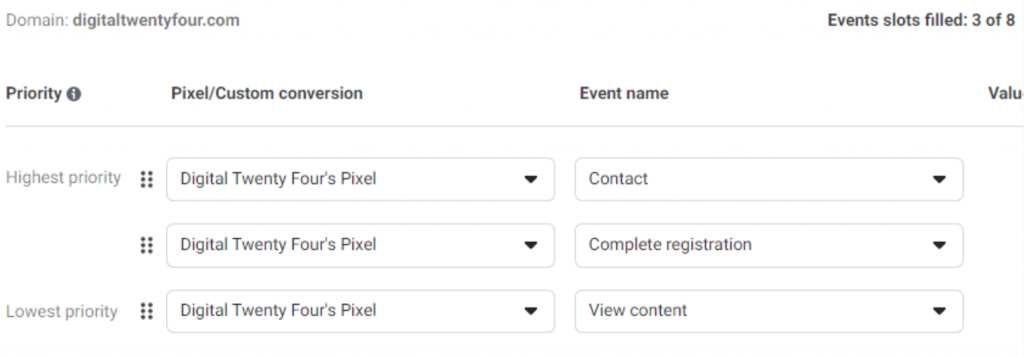
So long as you have verified your domain (discussed within this post), you will be able to add and prioritise your key events you wish to track. We highly recommend you do this before the final roll-out of ATT in March/April as Facebook state any changes may cause disruptions to your ads.
Delivery (value optimisation)
If you are in the e-Commerce space, it’s likely you’ve heard of Facebook Ads “Value Optimisation” (otherwise known as VO by many marketers). Reporting for VO tools include:
-
- ROAS (return on ad spend) – if for every £1 you spend, you get £3 of revenue this is a ROAS of 1:3.
- AOV (average order value) – The average amount of revenue made per purchase
- CLTV (customer lifetime value) – The average amount a user will spend on your website in their lifetime in repeat purchasing and individual purchases
Value optimisation (“VO”) is essentially optimising your ads not for Purchases, Leads or Contacts, but for “Value” e.g. Purchase Value or ROAS. Tools like this help us to see the bigger picture with our ads. Before these metrics, many users may have focused on the likes of CPA (cost per acquisition). However, if we consider the likes of Apple themselves who sell £39 chargers and £1,099 phones on the same store, CPA doesn’t make much sense. The reason for this is that if we focus on CPA, and we say “we are happy with a CPA of £50”, then we are actually losing money if we are only gaining purchases of the charger but gaining money on users who are purchasing the iPhone. Therefore, if we focus completely on the likes of ROAS, AOV or CLTV, we actually gain a clearer image of how our ads are generating revenue for our businesses.
And, if you were already stretched for space in your Events Manager (now capped at 8 events max), then we have some bad news for you. Facebook have stated that, “turning on value sets will automatically utilize 4 out of the 8 events allowed for campaign optimization and reporting for a given domain. Advertisers will have the opportunity to allocate up to 8 event slots to value sets for greater precision.”
In the future, Value optimisation will be moved from Facebook Ads Manager and into Events Manager where, if you have never used Value optimisation before, you will be required to configure it manually.
Measurement/Reporting
Now, here’s the real kick in the gut that’s keeping us all up at night. Measurement and reporting will take a big hit from the iOS 14.5 update. Previously, Facebook’s attribution models supported tracking as far back as 28 days with a 28 day click-through window (people that clicked on your ads within 28 days prior) and a 7 day view-through window (people that saw your ads within 7 days prior). This means that if someone clicked on your ad 25 days ago or saw your ad 3 days ago, for example, and then converted after thinking about it during that time, then your Facebook ads would get one conversion from that process. Great!
However, in light of the iOS 14.5 updates from Apple, Facebook will no longer be supporting this lengthy attribution window that we have all grown to love as marketers with our shiny successful reports. Now, Facebook is capping attribution to a 7 day click-through window and a 1 day view-through window which will pose significant changes to our ads reporting. Although your performance may not change significantly post-update, your Facebook Ads platform will be telling a different story simply because it cannot see as many of the conversions as it did prior. For us, we believe this is going to affect our higher product-value clients most significantly, being that these types of products have a longer consideration timeframe.
Facebook have stated, “In early 2021, attribution window settings for existing and newly created automated rules will no longer be supported, and a default window of 7-day click-through for non-iOS conversions and the SKAdNetwork window for iOS conversions will be implemented.”
How does all of this actually affect me?
If you are using a pixel to any capacity, for landing page views, purchases or app installs your ads will be affected. Facebook themselves have warned to “prepare for lower conversions” when iOS 14.5 is released in early 2021. But, how does all of this result in less conversions? Well, there’s a number of ways.
- With more users opting out of tracking and a smaller attribution window, conversions could be lower as they’re simply under-reporting. This doesn’t necessarily mean you get less conversions, it just means you are reporting less conversions.
- With lower reported conversions and lesser capabilities to retarget and generate detailed lookalikes using iOS users, performance may actually dip from previous months. This will be due to a longer-term loss of optimisation capabilities and spending a longer time in “learning phases”. We feel Facebook is going to need to adapt their learning phases to be a little more friendly to lower-conversion accounts off the back of the updates.
The latter point we believe will be the longer-term issue with performance ongoing, as rich optimisation events have always been key to strong performance on Facebook Ads.
What can I do today to reduce the impact of the iOS 14.5 update on Facebook ads?
Understand the impact before it happens
For us, we will be reviewing the potential impact for all of our clients before the changes are rolled out. Using breakdown reports, you can assess the number of impressions, clicks and conversions you’re currently gaining from iOS users to see the actual potential impact. For a number of B2B clients, we expect key devices to be Desktops and Androids and so these clients will be less affected. However, for most, we expect at least a 50% or more potential impact for market share reasons previously discussed.
You can access reporting using the Ads Reporting tool in Facebook Business Manager.
Familiarise with the new attribution window
In light of shorter attribution windows, we would also recommend using custom columns in your Facebook Ads manager to assess the potential loss of data with the new 7-day click through window and 1-day view through window. We recommend backdating your reporting so that you can familiarise yourself with what will eventually be “the new normal” (as if we haven’t heard enough of that phrase through 2020/21 already!)
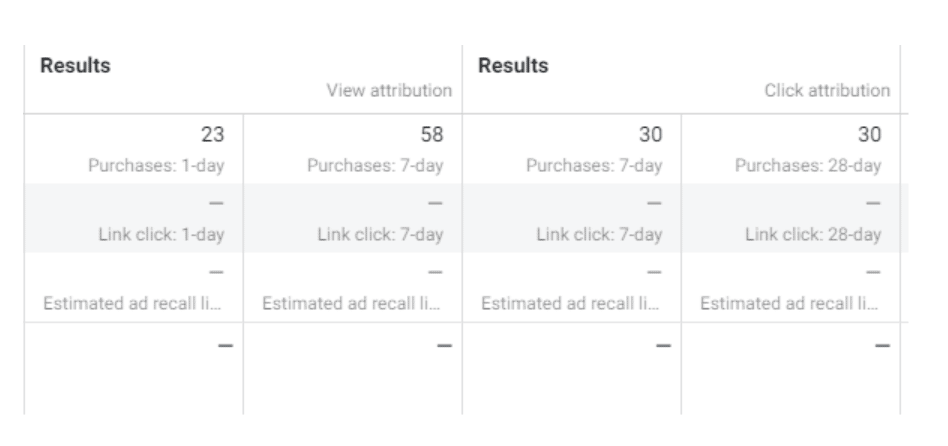
You can customise your columns in your Facebook Ads Manager platform. Simply click on “Columns: Performance” and go to “Customise Columns…”
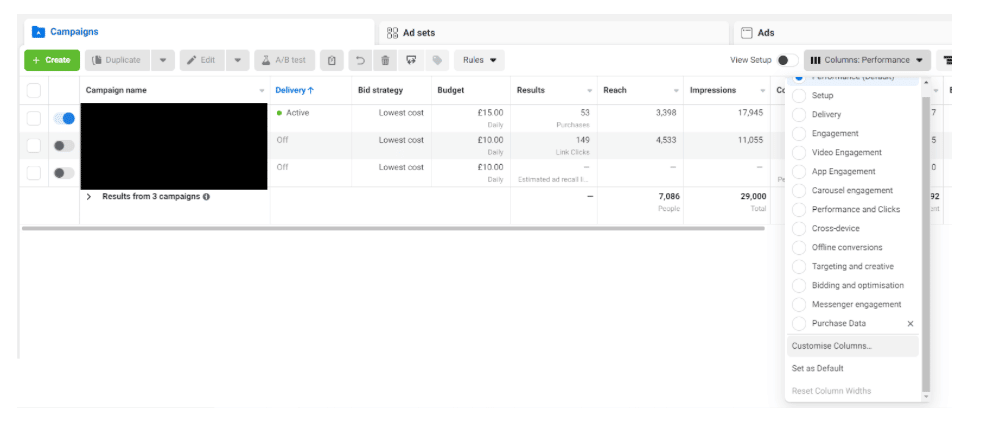
On the bottom right of the pop-up you can select “Window comparison”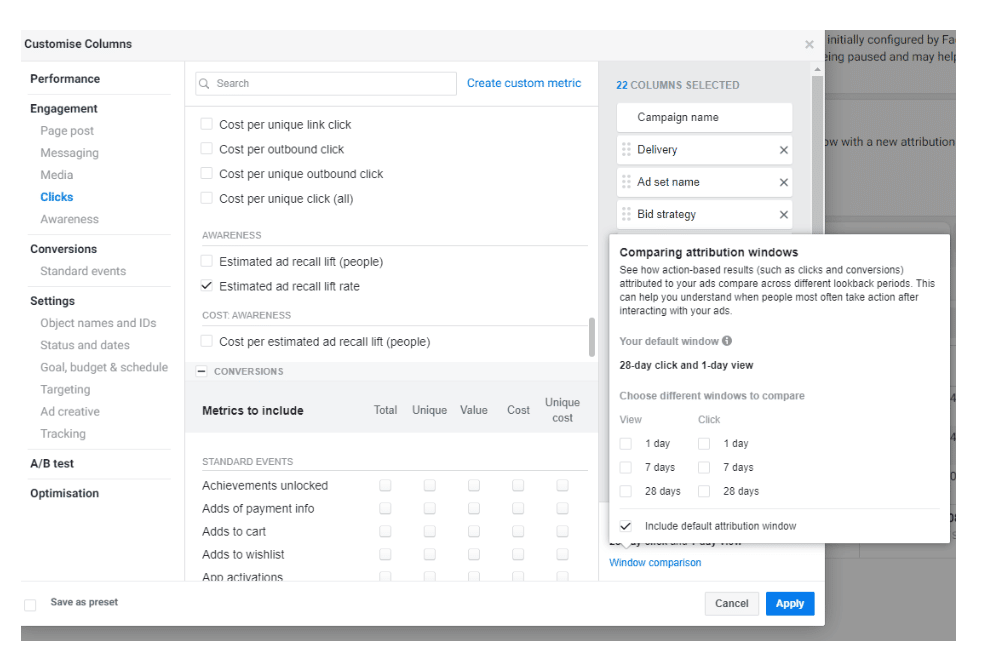
Select 7 days for Click and 1 days for View to represent the new upcoming Facebook attribution windows.
Verify your domain in Facebook ads Business Manager
One way Facebook is trying to push for users to prepare their Facebook ads platforms for the update is through domain verification. Facebook have stated, “We ask that you verify your domain… Domain verification will ensure no immediate or future disruption in the ability to configure conversion events”.
You can verify your domain in your Business settings > Brand Safety > Domains
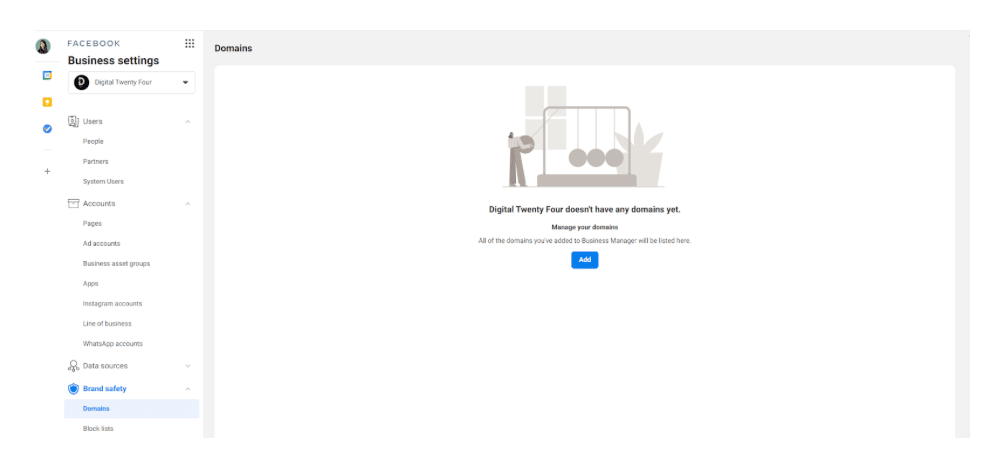
Refresh your screen and you will see that your verification is pending. You will have 3 options for verification including DNS verification, HTML file upload and Meta-tag verification. 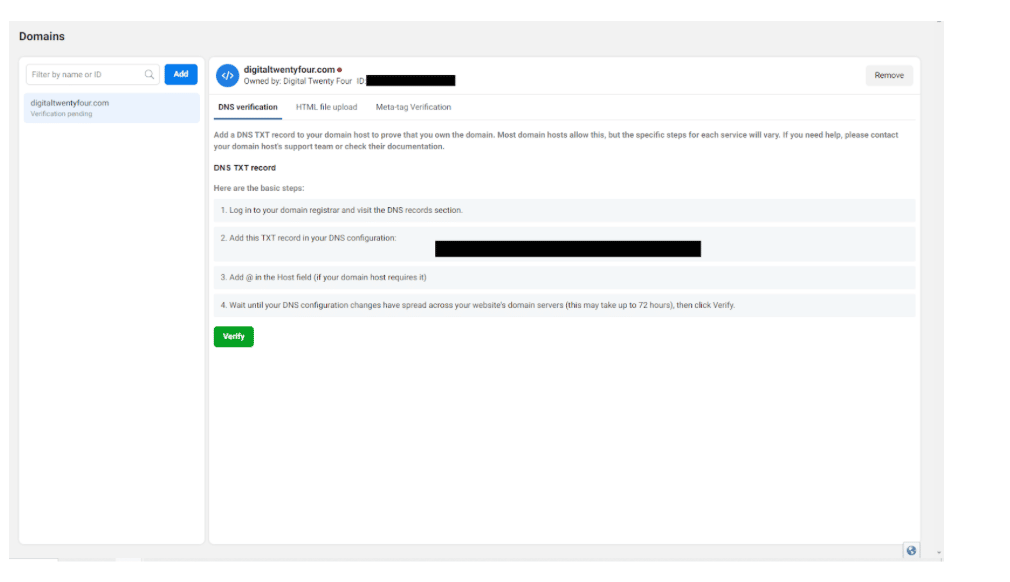
DNS verification involves adding data to your domain host e.g. GoDaddy. Instructions are offered on-screen, however, if you are unsure, we recommend you contact your developer.
HTML file upload requires you to have access to your root domain to upload this file. Again, if you are unsure how to do this, we recommend you contact your developer.
Meta-tag verification is the easiest way to verify your website if you are using a CMS such as Shopify or WordPress (for example). This allows you to apply a code between the <head> tags of your website’s code as you would any other tracking code whether it be your Facebook Pixel or Google Global Site Tag. However, if you are unsure how to do this, we (say it with me) recommend you contact your developer.
How we’ll be combatting Events drawbacks
Unfortunately, there’s no other way around it than to reduce the number of events you are tracking if they equate to over 8 slots (including 4 for value based optimisation). We recommend prioritising your highest value events in your account as soon as possible to ease into the change earlier on and only optimising your campaigns to these select events within your campaigns.
If you would like to remove events altogether, in some cases, you can click “Manage event” after dropping down a specific Event and delete the source this way within your Events Manager. Otherwise, if this is a Standard Event or Custom Event you have manually placed on your website, you should remove the pixel event from your website’s code.
How we’ll be combatting Measurement and Reporting drawbacks
One way in which we will be combatting Measurement and Reporting issues with the drawbacks now posed by Facebook’s tighter attribution windows will be to make use of custom UTM tracking parameters on URLs and setting up custom Default Channel Groupings through Google Analytics.
Actions like this will help us to use Google’s Assisted Conversions Tool to see the wider picture of conversion funnels and paths and fully assess Facebook Ads’ impact on our overall e-commerce activity. Ah, trusty old Google!

Although this is simply a patch on a large issue of tracking and optimisation directly from Facebook as we understand we’ll probably be spending more time in “Learning” phases, it gives us slightly better visibility into our user journey and actual conversion sources if we have a longer consideration cycle.
Feel free to contact us if you would like to discuss iOS 14.5 in more depth and how it affects your business.
Post-iOS14.5 Known Issues with Facebook ads & Fixes (Updates)
Why is my Facebook ads campaign performance showing as blank when I know there have been conversions?
If your Campaigns are showing blank performance, when you can either see the conversions at ad set level or know there have been conversions from Facebook, then you may need to review your selected attribution windows.

To check this, make sure your columns are set to “Performance (Default).
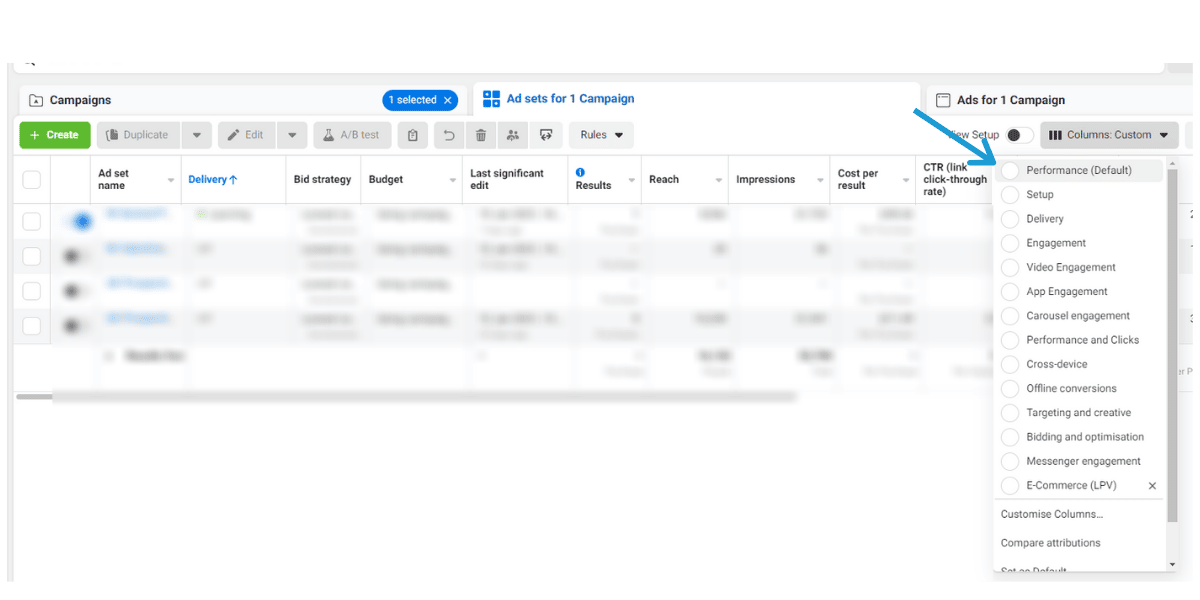
Within Performance (Default) you will be able to see the column “Attribution setting”

If you can see different Attribution windows within one campaign (in this case we have 3 ad sets with 28-day click and 1 ad set with 7-day click), then Facebook ads will not show any performance at campaign level, similarly to having different conversion objectives within one campaign.
You need to update all ad sets to have the same attribution window within this campaign. To do this:
- click to Edit your ad set
- Scroll to the bottom of the Ad set editing screen and click “Show more options”
- Edit your conversion window to fit other ad sets
- Save

You should now be able to see your performance at campaign-level.
